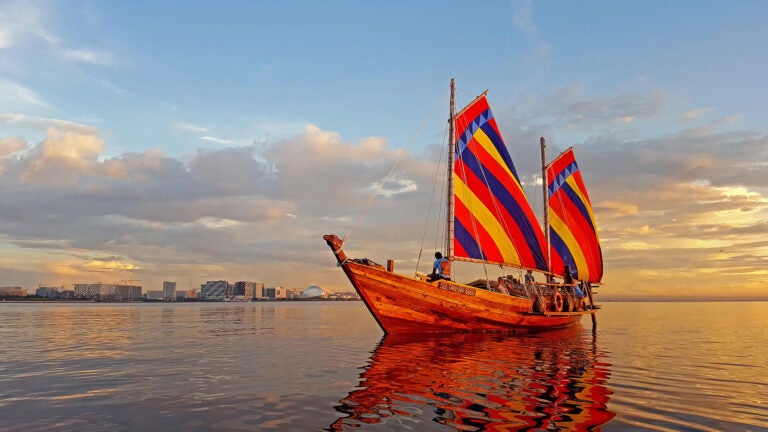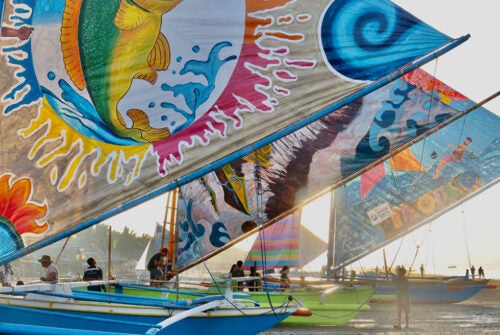
A ship, and a sailor, reborn
In the tropical archipelago that constitutes the Philippines, an ancient ship is being reborn, heartwood plank by heartwood plank. The balangay, a type of boat Filipinos sailed throughout the Pacific Ocean for thousands of years, has been largely missing from the waves since Spanish colonizers arrived in the islands in the mid-16th century and suppressed boat construction.
In 2009, Filipino explorer Arturo Valdez led a team which revived this maritime tradition and built three traditional balangays. They sailed their boats hundreds of miles across the ocean, visiting countries like Singapore, Vietnam and China.
Valdez and a team of researchers are now rebuilding their fleet of balangays, this time carefully recording the process to ensure the continuation of this tradition. Once their boats are ready, they aim to use them to train a new generation of Filipino sailors in the old ways.
On hand to film this journey is Jordan Winters, who graduated in 2019 from the USC Dornsife College of Letters, Arts and Sciences with a political science degree and a degree in journalism from USC Annenberg School for Communication and Journalism. She’s producing a documentary on the balangay voyage as a Fulbright-National Geographic Storytelling Fellow.
It’s a deeply personal project for Winters, both as a Filipino American and because it’s the culmination of a long, personal return to the ocean. A childhood sailing accident left her entire family spooked on boats for over a decade.
“We weren’t in mortal danger, but as a kid it was very scary,” says Winters. “It became my father’s ghost story for years on why we don’t go on the water anymore.”

Like father, like daughter
Winters was born and raised in San Francisco, California, where her father first got her hooked on the art of narrative. On camping trips with her Girl Scout troop, he’d regale the campers with his own versions of sci-fi films like Alien and Close Encounters of the Third Kind. He took his daughter hiking and used old mining trails or signs declaring “Your Tax Dollars at Work” as jumping off points to discuss history and politics.
“He was showing me how to gather evidence and also think about the bigger picture at play — things I still do today in the field,” she says. It was also her dad’s inquisitive spirit that led the family to rent a sailboat for the day out on the San Francisco Bay, just to try out the sport they’d all been admiring on dry land. A few hours, a capsizing and an extraction by trained rescuers later, the family was back on the dock swearing off any more future seafaring.
Arriving at USC, Winters knew she wanted to become a journalist and enrolled as a journalism major at USC Annenberg. To broaden her studies, she added a political science degree at USC Dornsife.
Anthony Kammas, professor (teaching) of political science, was a favorite instructor. “I took every class that he offered. He made us think a lot about the difference between a utopia and a dystopia, and about the social contracts we all make. I still use what I learned in his classes, because a boat is its own contained society and you put your life in each other’s hands,”” says Winters.
USC also honed her journalism skills. Winters worked with Robert Hernandez, professor of professional practice at USC Annenberg, in his JOVRNALISM project, which took her to South Korea to report on the 2018 Olympics as well as to Qatar.
“USC is a unique school. It could provide both the academic rigor of my political science degree and also hands-on job-focused training at Annenberg,” she explains.
College was also about conquering some personal demons. The summer between her freshman and sophomore year, Winters’ father decided it was time the family rid themselves of their aquaphobia. He persuaded his daughter to join him in sailing classes back at the scene of the original incident in the San Francisco Bay.
Winters was ready. “I came from this ancient maritime tradition. I felt like I had a birthright to be on the water,” she says.
Those lessons ended up kicking off a new family hobby. Winters and her dad now compete in sailing races together, and he’s sailed across the Pacific Ocean twice.
New horizons
As graduation loomed, a formative conversation with USC Annenberg professor Gabriel Kahn steered Winters toward the idea of working abroad. He helped her apply for a grant to attend a journalism conference in Chang Mai, Thailand, which opened up new perspectives on international journalism.

“It solidified that I wanted to come back to Asia,” says Winters. “It gave me a sense of real opportunities there, stuff to do outside of the main media bureaus.”
Winters started on her application for the Fulbright-National Geographic fellowship the day after she graduated. She wasn’t precisely sure of her research angle until some internet searching led her to Valdez’s balangay project. She knew narrative potential when she saw it.
“A boat gives you defined characters going against a concrete challenge with a beginning, middle and an end,” says Winters. “A good pitch has those elements; I learned that at Annenberg.”
She submitted her application and was awarded the fellowship in 2020, but the COVID-19 pandemic put the project on pause. She worked at NBC News as a producer in New York City and Miami before finally getting the greenlight to head to the Philippines in January, nearly three years after she put in her original application.
“It was a lesson in patience,” says Winters.
A ship’s resurrection
Now, she’s following along as Valdez, his crew and a team of researchers build a fresh set of boats. Little in the way of historical balangays survives, so much of the project involves “experimental archeology,” in which theories about how things may have been constructed in the past are tested and then adjusted.
For instance, all original fabric sails have long ago rotted. The team must examine local resources, such as finding out which available indigenous fibers would have been strong and abundant enough to use for sailcloth, to guide them in producing new ones. It’s a puzzle that raises fascinating questions for a sailor like Winters: Is a “crab claw” sail as good as a square sail? Could they have made it to China if they used a sail that could produce only five knots versus 10 knots of speed?
Once the boats are built, Winters will tag along with her camera as Valdez and his crew take the balangays to sea. With more than 7,000 islands in the Philippines to explore, it’s a sailor, and storyteller’s, paradise.